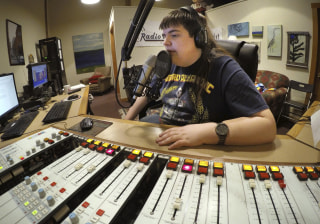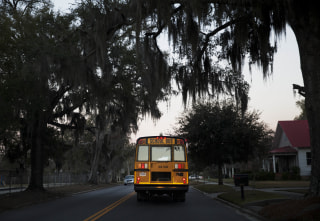Sexual Assault by Fellow Students: 17,000 Reports in 4 Years, AP Investigation Finds
by
BRUNSWICK, Maine — Chaz Wing was 12 when they came after him. The classmates who tormented him were children, too, entering the age of pimples and cracking voices.
Eventually, he swore under oath, the boys raped him and left him bleeding, the culmination of a year of harassment. Though Chaz repeatedly told teachers and administrators about insults and physical attacks, he didn't report being sexually assaulted until a year later, launching a long legal fight over whether his school had done enough to protect him.

The AP does not usually name alleged victims of sexual assault, but Chaz and his parents decided to speak publicly in hopes of helping others.
Chaz's saga is more than a tale of escalating bullying. Across the U.S., thousands of students have been sexually assaulted, by other students, in high schools, junior highs and even elementary schools — a hidden horror educators have long been warned not to ignore.
Relying on state education records, supplemented by federal crime data, a yearlong investigation by The Associated Press uncovered roughly 17,000 official reports of sex assaults by students over a four-year period, from fall 2011 to spring 2015.
Though that figure represents the most complete tally yet of sexual assaults among the nation's 50 million K-12 students, it does not fully capture the problem because such attacks are greatly under-reported, some states don't track them and those that do vary widely in how they classify and catalog sexual violence. A number of academic estimates range sharply higher.
"Schools are required to keep students safe," said Charol Shakeshaft, a Virginia Commonwealth University professor who specializes in school sexual misconduct. "It is part of their mission. It is part of their legal responsibility. It isn't happening. Why don't we know more about it, and why isn't it being stopped?"
Elementary and secondary schools have no national requirement to track or disclose sexual violence, and they feel tremendous pressure to hide it. Even under varying state laws, acknowledging an incident can trigger liabilities and requirements to act.
Sexual abuse allegations can be difficult to investigate. Because many accusers initially keep quiet, physical evidence can be long gone once investigators step in. Often, there are no eyewitnesses, leaving only the conflicting accounts of the accuser and the accused.
Ranging from rape and sodomy to forced oral sex and fondling, the sexual violence that AP tracked often was mischaracterized as bullying, hazing or consensual behavior. It occurred anywhere students were left unsupervised: buses and bathrooms, hallways and locker rooms. No type of school was immune, whether it be in an upper-class suburb, an inner-city neighborhood or a blue-collar farm town.
Unwanted fondling was the most common form of assault, but about one in five of the students assaulted were raped, sodomized or penetrated with an object, according to AP's analysis of the federal incident-based crime data.
About 5 percent of the sexual violence involved 5- and 6-year-olds. But the numbers increased significantly between ages 10 and 11 — about the time many students start their middle-school years — and continued rising up until age 14. They then dropped as students progressed through their high school years.
The AP counted only the most severe forms of sexual assault, excluding categories that were more broadly termed, such as sexual harassment, or behavior like kissing on the playground.
Contrary to public perception, data showed that student sexual assaults by peers were far more common than those by teachers. For every adult-on-child sexual attack reported on school property, there were seven assaults by students, AP's analysis of the federal crime data showed.

Laws and legal hurdles also favor silence. Schools have broadly interpreted rules protecting student and juvenile privacy to withhold basic information about sexual attacks from their communities. Victims and their families face high legal thresholds to successfully sue school districts for not maintaining safe learning environments.
"Everyone feels like we don't have a problem, and the reason they feel that way is they have their heads in the sand," said Oregon psychologist Wilson Kenney, who has helped develop student intervention programs.
Student-on-student sexual assaults live in the shadows compared to the attention paid to gun violence in schools, most notably the Newtown shooting, Kenney noted. "There's no Sandy Hook for sexual misconduct. But I think the potential harm is great," he said.
School districts have had to report all sorts of data about students, from those who received free lunches to those who brought in firearms. But there is no federal mandate to track sexual violence.
By contrast, colleges and universities must keep a public crime log, send emergency alerts about sexual assaults, train staff and aid victims under a federal law named for a student who was raped and murdered in 1986.
"Obviously, we care enough to make colleges report," said Kansas City, Mo., lawyer Chris Dove, who has represented peer sex-abuse victims. "Shouldn't we care even more about kids under 18?"
Settlement amounts can be so low that lawyers are reluctant to take on what are typically lengthy, complicated cases. For families, the painful and costly process usually is driven by more than a desire for money.
Chaz marks progress by the seasons.
"The fall is always a hard time for me every year," Chaz said, "because that's the time that the first assault happened. That's the time when I was finally able to tell my mom about what had happened."
Chaz continued to miss class his first two years at his new technology and science high school, where he received specialized instruction because of his depression and PTSD. After changing medication, he missed fewer classes. He sees a counselor every other week.
In a few weeks, Chaz turns 18 and will graduate. He'd always sworn he'd never leave Maine. Recently, though, he's been thinking about studying or working out of state. It's a sign his horizons may be widening.
"I'm still not really sure what I'll do," Chaz said. "Life is an open road."








No comments:
Post a Comment